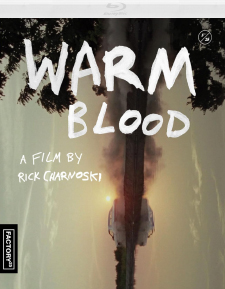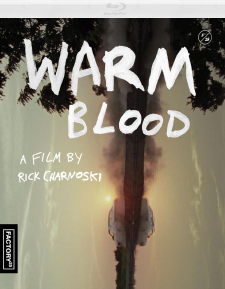Warm Blood (Blu-ray Review)

Director
Rick CharnoskiRelease Date(s)
2022 (December 26, 2023)Studio(s)
Curious Film/Six Star (Factory 25/Vinegar Syndrome)- Film/Program Grade: D
- Video Grade: B-
- Audio Grade: B+
- Extras Grade: C
Review
Warm Blood, the first feature film by director Rick Charnoski, uses a troubled young woman’s search for her father as a device to take a close look at the drug addicted and homeless population of Modesto, California in the 1980s.
There’s not much of a plot. Red (Haley Isaacson) is an emotionally numbed runaway recovering from a stay in a mental hospital. She returns to Modesto to seek her father, who may or may not have had an affair with her best friend, Piper (Selena Spurgeon), when she and Piper were adolescents. Her search takes her through a collection of substance abusers, drifters, and homeless people, many of whom live near a polluted river.
To survive, Red steals and cons her way through life. In periodic emotionless voiceovers, she quotes from the diary she started during her time in therapy and has continued ever since, including the entry dates.
Red eventually meets aimless teenager Tom (Ryan Toothman), who has a car and chauffeurs her around the city’s run-down streets. As they encounter assorted colorful, often scary-looking individuals, many as directionless as they are, a serial killer may be at large. A local news crew headed by an aggressive reporter (John Veit) are hot on what could be a big story.
The film’s structure is disjointed and often seems like an unedited documentary, making it difficult to follow. Isaacson’s performance is so monotonous that it’s hard to identify with her pain. Yes, she’s a damaged human being, but there has to be a trace of humanity for the viewer to respond to. As the film’s protagonist, her Red is colorless and dull. Whether her performance is the result of bad acting or poor direction is unclear. The sprawling narrative is composed of episodic moments rather than a strong plot line, adding to the picture’s ill-thought-out feel.
Clarity is important. It’s the director’s job to make sure the viewer can follow the narrative. Charnoski fails to do this. With a muddled collection of scenes and frequent tangential forays, he creates a confused jumble instead of what could have been a fascinating look at a grim, desperate lifestyle. Trying to piece together what the director is attempting is a burden the viewer should not have to bear.
Warm Blood has an indie-sleaze appearance with its frequent use of hand-held camera shots, long uninterrupted takes, and use of available light. Director Charnoski employs gimmicks such as fast moving, upside-down images, montages, and improvisational acting, techniques that characterize guerrilla filmmaking. His background in making skateboard videos was evidently insufficient to prepare him for the discipline of telling a coherent feature-length story. There’s also an insincerity about the film. An opening on-screen title tells us that the film is “Based on actual events,” yet it’s never more than disconnected images of down-on-their-luck people struggling to survive.
Warm Blood was shot by director of photography Christopher Blauvelt on 16 mm film and is presented in the aspect ratio of 1.78:1. There’s little information about equipment used in the production, but many scenes appear as if they were shot on the fly. Most memorable are the shots of real Modesto people, prematurely aged and missing teeth, who often stare wordlessly into the camera. Actors and real folks intermingle and contribute to the film’s documentary feel. Lighting varies, and some scenes shot at night are barely visible. The photography often suggests a stream of consciousness as Red navigates her surreal world.
The soundtrack is English 2.0 Dolby Digital. English SDH subtitles are an available option. The stereo track displays excellent channel-to-channel movement. Red’s narration periodically footnotes the action, and cutaways to the news crew reporting on local killings add a sense of impending menace. The polluted river, Tom’s car engine, campfire camaraderie, a brutal fight, and heavy rain constitute the film’s primary ambient sounds.
Bonus materials on the Region-Free Blu-ray release from Factory 25 include the following:
- Faces (19:15)
- Figuring It Out: Video Test Shoots vs. Final Film Scenes (15:18)
- Creeping Around Modesto with Andy Roy (27:41)
- Trailer (:48)
Faces – After wrapping each scene, director Rick Charnoski asked Christopher Blauvelt to shoot a 16 mm portrait of whomever was in that scene. This featurette is a collection of those portraits, accompanied by a song composed by Ariel Courtin-Wilson and his father, Peter.
Figuring It Out: Video Test Shoots vs. Final Film Scenes – Director Charnoski went to Modesto as often as he could with a video camera while figuring out the film. After four years of doing this, he finally met his two leads, Haley Isaacson and Ryan Toothman. He started following them around with his video camera to see what it looked and felt like. He followed the same process with many of the people he met. Some of his “research” videos wound up in the final film. Others were adapted from video to scenes in the film.
Creeping Around Modesto with Andy Roy – Director Rick Charnoski met Andy Roy in Modesto in 2011, told him about this movie idea, and asked if he’d like to help. They spent years combing Modesto, collecting bits and pieces of stories. The stories, places, and people they found ended up being the foundation of Warm Blood. Charnoski and Roy discuss how their search transpired and talk about eluding authorities when they filmed.
Booklet – The 24-page enclosed booklet contains full cast and crew listing; a director’s statement; the articles Warm Blood by Christopher Carnoski and Trash Magic by Megan Leonard; and background information about the bonus extras.
Warm Blood is a collage of thoughts, images, locations, and sounds that provide a hazy impression of lost lives being lived in the dull, drab part of a California town. Every now and then there’s a good moment, but waiting for them can easily try a viewer’s patience. In a statement in the enclosed booklet, Charnoski admits that when he was making the film he didn’t know what he was doing. That lack of expertise is painfully obvious.
- Dennis Seuling

